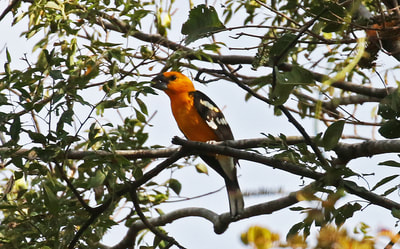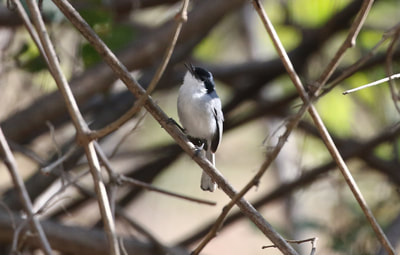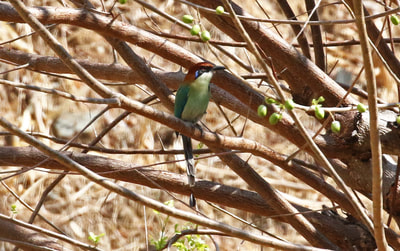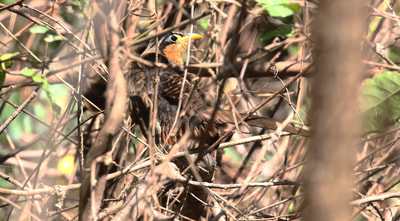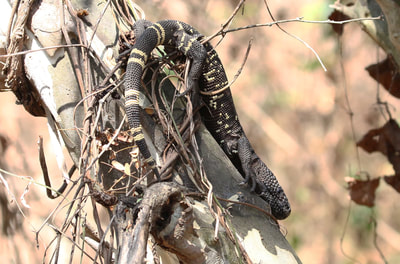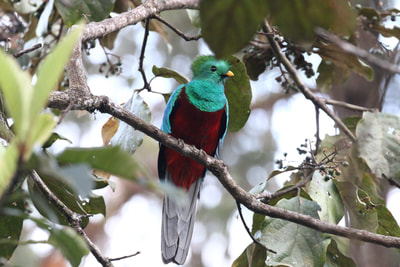5th March
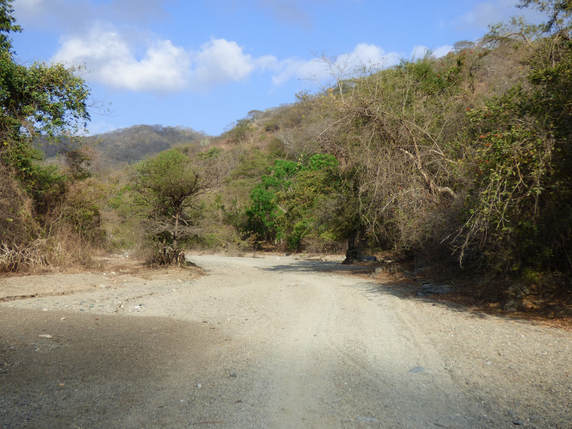 Typical Motagua habitat
Typical Motagua habitat
Another early start as we were due to drive up into the Motagua river valley, on the rain shadow side of the mountains, and so the driest region in the country. We emerged into the dawn light from our rooms to be confronted with ..... rain!! After breakfast it had more or less stopped and by the time we had driven to the target location, called, to give it its full name, Reserva Natural para la Conservacion del Heloderma, the sky was blue and it was warming up. The area was unlike any of the previous locations we had visited, being very dry, with the vegetation consisting of cacti, thorny bushes and the like. We birded along a dusty track looking for the specialist birds of this habitat. We had a couple of raptors - an Ornate Hawk-eagle overhead and a Sharp-shinned Hawk flying through. We found two Squirrel Cuckoos and then a Lesser Ground Cuckoo was heard, and after some patient searching of this skulky species, sharp-eyed Aaron found it in a tangle of scrub, where it eventually gave good views and even allowed a photo or two! A Ferruginous Pygmy-owl sat in a tree for us, and then we found another specialist of the area, a Russet-crowned Motmot, and shortly after that, its Turquoise-browed cousin. Streak-backed Orioles were quite numerous and on the hummingbird front we had Canivet's Emerald and Cinnamon Hummingbird. Farther on along the track we found the stunning Yellow Grosbeak of the subspecies aurantiacus which is restricted to southern Mexico and Guatemala. Other new birds were the tiny White-lored Gnatcatcher, and as a fly-by, a White-fronted Amazon. Eventually we reached the reserve centre buildings. This reserve was created for the main purpose of preserving the endangered Guatemalan Beaded Lizard, or Heloderma which translates as 'beaded skin'. These are closely related to the Gila Monster which is found in the southern part of the USA. The Guatemalan, or Motagua Valley Beaded Lizard is a subspecies [charlesbogerti] of the Mexican Beaded Lizard [Heloderma horridum]. The two species, Mexican and Gila are the only two venomous lizards in the world, and the Guatemalan subspecies can only be found in the Motagua Valley. The guide at the reserve showed us a juvenile and a fully grown adult which was allowed to wander around [they are pretty sluggish movers] so we could take some photos - I was allowed to touch the skin of the adult and it felt like it was covered in plastic beads. Although venomous, due to their sluggish movement they present little danger to humans. As it is a specialized predator that feeds primarily upon eggs, the primary use of its venom is still a source of debate among scientists. However, this venom has been found to contain several enzymes useful for manufacturing drugs in the treatment of diabetes, and research on the pharmacological use of its venom is ongoing.
Whilst at the reserve centre, we had the good fortune to see a Nutting's Flycatcher, another southern Mexico and Central American special. We then walked back to the bus, and on the way, found a male Elegant Trogon which allowed good views.
Whilst at the reserve centre, we had the good fortune to see a Nutting's Flycatcher, another southern Mexico and Central American special. We then walked back to the bus, and on the way, found a male Elegant Trogon which allowed good views.
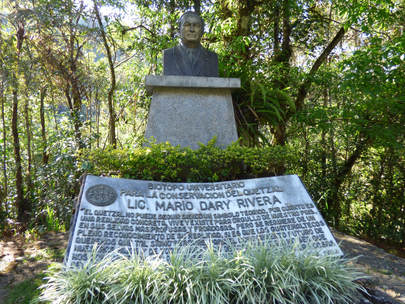 Monument dedicated to Dary Rivera
Monument dedicated to Dary Rivera
Our destination this afternoon was the cloud forest of Biotopo del Quetzal in the central highlands, so we headed more or less north from the dry valley. We stopped at what was to be our lunch venue, only to find it closed, so we drove a bit farther along the road and found another restaurant where we had yet another tasty lunch. That done we then headed to the Biotopo del Quetzal Reserve, which is also known as Biotopo Mario Dary Rivera, named after an environmental campaigner who did a lot to preserve this area. There was a statue of him near the reserve entrance building. There are just two fairly short trails in the huge area of forest so we walked one of them for an hour or so. We found a good selection of species, including Highland Guan, White-collared and Vaux's Swifts overhead, Collared Trogon, our old friend the Northern Emerald Toucanet, Cabani's Wren, Grey-breasted Wood-wren, which was new for the trip, Brown-backed Solitaire, then another new bird in the form of a Northern Waterthrush in a small wet gully, American Yellow, Black-throated Green and Wilson's Warblers, a Common Bush-tanager and Unicoloured Jay. We wandered back to the reserve centre building and were looking around when suddenly there was a shout - Aaron appeared from the direction of the the car park - he'd got a pair of Resplendent Quetzals in a tree by the car park! We all rushed down and there they were, feeding in a tree right by the road! Needless to say a lot of camera shutters started clicking. Although the light wasn't overly good I managed to get some good shots of both. What an end to the day! We finally set off for the short drive to our accommodation at Ram Tzul hotel. This was a delightful place with a main building and cottages dotted around the sloping grounds and gardens. Some of us had time for a quick wander around before dinner, and we were treated to a group of c.20 Chestnut-headed Oropendolas which were going to roost in a tree.
